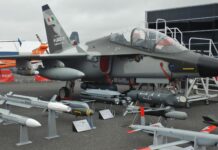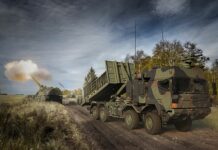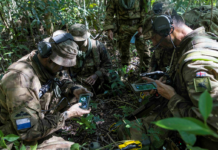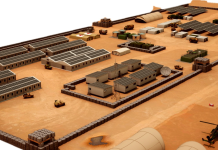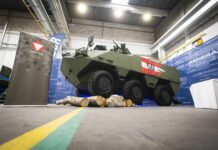The Austrian Bundesheer Luftstreitkräfte has come a long way since their first forays into rotorcraft, and continues to evolve with the twenty-first century. The Bundesheer, or Austrian Armed Forces, has operated a variety of American, British, French and Italian rotary wing platforms over seven decades. The Luftstreitkräfte, or Air Force part of the Bundesheer, currently operates nine (Lockheed Martin owned) Sikorsky S-70 BLACKHAWKs, in use since 2001, and several legacy air frames consisting of the single engine Aerospatiale (now known as Airbus Helicopters) ALOUETTE III, Bell OH-58C KIOWA and the twin engine AgustaBell 212 Twin HUEY.
In 2017, the newly established Kommando Luftstreitkräfte, or Air Force Command, which is headquartered in Salzburg, had the responsibility for overseeing the readiness and preparation of the air force assets. The rotary wing fleet assets are spread across the country, from the east in Schwaz in the state of Tyrol, to Linz-Hörsching Flughafen (Airport) in Upper Austria, to Allentsteig in Lower Austria, and in the south at Klagenfurt in the state of Carinthia, and finally to the borders at Punitz, in Burgenland state.
Alpine Pioneers Post-War
The very first rotorcraft seen in Austria was in the early 1950s, a Sikorsky (S-51) H-5 DRAGONFLY from the newly established United States Air Force (USAF). In the post-war period Austria was allowed to re-arm. In 1956, the country took on its first helicopter (and also their first turbine powered craft), which was the AgustaBell AB-47 single piston engine helicopter, which was licenced and built in Italy by what was then Agusta (now Leonardo) from Bell Helicopters. The Bell 47, with its iconic bubble canopy, was made famous during the Korean War as a liaison and Casualty Evacuation (CASEVAC) helicopter with the US Army.
This was followed by a training helicopter in liaison with the US Navy, the French-built Aerospatiale ALOUETTE II three seat observation helicopter powered by the Turbomeca Astazou engine, and then the British Westland WHIRLWIND medium lift helicopter. The piston engine WHIRLWIND was licensed and built in the United Kingdom from the American Sikorsky S-55. The S-55 served across the US Air Force, Army, Marine Corps and Navy and had seen combat for the first time during the Korean War from 1950-1953. The Bundesheer entered the turbine helicopter world with the introduction of the Sud Est (Aerospatiale, which then became Eurocopter and Airbus Helicopters today) ALOUETTE II three seat (bubble canopy again) observation with sixteen airframes ordered, which stayed in service until 1975. This also began a closer relationship with France, as later they ordered the larger ALOUETTE III in 1967.
In 1960, the Austrians again took delivery of the iconic piston single engine Bell OH-13 SIOUX (Bell 47), then in 1963, the AgustaBell 204B Huey, which was again manufactured under licence in Italy by Agusta from Bell Helicopters in the United States, and the aircraft was not retired until 2001. They also ordered the AgustaBell 206 JET RANGER (licensed built variant of the popular Bell 206B JET RANGER) in 1969, which served for four decades.
Sikorsky – Short but Strong
In 1969, the Austrian Air Force selected the large twin engine Sikorsky S-65O STALLION, which was finding fame with the US Marine Corps, Air Force and Navy at the time in the South-East Asian conflict. Two of these heavylift helicopters entered service, albeit for a relatively short period between 1972 and 1981, before being retired and sold to Israel. The STALLION was entering service with their German neighbours with the army aviation (Heeresflieger) around the same time. It would be three decades before a Sikorsky airframe returned to the inventory.
The Dawn of the HAWK
In February 1999, a large avalanche hit the village of Galtur, south of the famous ski resort town of St Anton, in Austrian Tyrol. 31 people had already lost their lives to this accident by the time the emergency services were at the scene. There was an international response with the Sikorsky UH-60A BLACKHAWK ‘Dustoff’ Medical Evacuation (Medevac) from the United States in Europe (USAREUR) based in Germany, along with the German Federal Border Guard (Bundesgrenschutz) Eurocopter AS332L1 SUPER PUMA. The German Army Aviation (Heeresflieger) provided the single engine Dornier-Bell UH-1D Huey, and twin engine heavylift Sikorsky CH-53G STALLION, while the Swiss Armed Forces (Schweiz Armee) sent their Eurocopter AS532 COUGAR, as did the French Air Force (Armee de l’Air). These came to supplement the Bundesheer AB-204B, AB-212 and ALOUETTE III and local civilian helicopters. In the aftermath of the avalanche, there were public inquiries as to why the disaster happened in this supposedly safe zone, and, more importantly for our interest, it highlighted the inadequacy of the Bundesheer rotary wing force at the time.
The result was the launch of a competition for a medium utility helicopter, and the airframes offered ranged from the three engine EH Industries EH101 MERLIN (now known as the Leonardo AW101 Merlin), the S-70 BLACKHAWK from Sikorsky, and the new twin engine H-92 SUPERHAWK. Eurocopter offered the SUPER PUMA/ COUGAR, and, in a surprising move, the Russians offered Kazan Helicopters MI8/17, considered as reparations from World War Two.
In October 2000, the Austrians selected the Sikorsky S-70 BLACKHAWK, purchasing nine airframes that were delivered in 2002, making them the second European customer after Turkey at the time. The Austrian BLACKHAWKs were one of the first export models to have a digital cockpit.
The A is in Austrian and AceHawk
The BLACKHAWK fleet continued to evolve. During December 2013, the United States Defence Security Cooperation Agency (DSCA) with the State Department, approved a possible Foreign Military Sale (FMS) of three UH-60M BLACKHAWKs. The Austrian requirement included a trio of Aviation Survivability Equipment (ASE) with seven T700-GE-701D Engines (six with one spare), a trio of Aviation Mission Planning Systems and a Transportable BLACK HAWK Operations Simulator (TBOS). Finally, there were going to be eight AN/ AVS-9 Night Vision Goggles (NVG), and an Aviation Ground Power Unit, along with eight Embedded Global Positioning Systems (GPS) with Inertial Navigation in the whole package.
However, in 2017, American company Ace Aeronautics LLC of Huntsville, in Alabama, was awarded a US$40M contract to upgrade the avionics of nine BLACKHAWKs in the inventory with their AceHawk package. This package comprises a Garmin 5000H cockpit, with four 12-inch UltraHD displays which are NVG compatible, and two touchscreen controllers. In November 2020, the first modified, upgraded BLACKHAWK was delivered from Ace Aeronautics to Austria.
In 2019, the Austrians had approached Ace Aeronautics and ordered an additional three UH-60 platforms to be equipped with the ACE DECK VL-60 cockpit, with similar features to their AceHawk package. In 2020, the Austrians purchased three former Royal Jordanian Air Force (RJAF) BLACKHAWKs, and after obtaining approval from the United States for the transfer, the three BLACKHAWKs will be sent to Huntsville for the modification and are expected to be delivered by the end of 2022.
Legacy of Leonardo
A strong relationship continues between the Austrians and the Italians to this day, as the Federal Ministry of Defence (known as the Bundesministerium für Landesverteidigung, or BMLV), in September 2020, selected the Leonardo AW169M as the next generation Light Utility Helicopter (LUH). This six tonne Pratt & Whitney multi-engine powered helicopter is primarily to replace the legacy ALOUETTE III in the trooping/ utility role, as well as Search And Rescue (SAR), and supporting special forces, amongst other missions.
In January 2022, Leonardo and the Italian Secretariat General of Defence/ National Armaments Directorate signed the Acquisition Contract for the supply of AW169M Light Utility Helicopters (LUH) to the BMLV.
The Austrian Bundesheer is the third customer for the AW169M after the Italian Finance Police or Customs Service (Guardia di Finanze,) and the Italian Army Aviation (Aviazione dell’Esercito). The AW169M is the military version of the popular AW169 which was unveiled to the aerospace community at Farnborough Air Show 2010, when the company was known as AgustaWestland. A mock-up of an armed AW169M was shown at Farnborough 2014, on static at the chalet. The AW169 made its maiden flight in May 2012 and is often found in the parapublic role, be it police air support or Helicopter Emergency Service (HEMS), around the world. The first AW169M went to the Guardia di Finanze in 2019 and appeared at the Austrian Airpower 2019 Air show at Zeltweg air base.
Ascending Higher and Higher
In spite of being a neutral country, the Bundesheer does have international contacts across the borders. For example, Austrians have pioneered high altitude mountain flying from the late 1950s onwards, and the Bundesheer runs a High Altitude Mountain Pilot Course, to which several NATO members sent their helicopter crews. Pilots from the British Royal Air Force (RAF), and from the Boeing CHINOOK and Aerospatiale PUMA community would fly in the Aerospatiale ALOUETTE III, while Army Air Corps (AAC) pilots, used to flying the then Westland LYNX and GAZELLE, would fly in the Bell OH-58C KIOWA, for the duration of the course. The course teaches everything from whiteout to experiencing landing at 10,000 feet or above in the mountains, and how to acclimatise with or without oxygen. The Germany based USAREUR helicopter crews (primarily then using Sikorsky UH-60A/L and Boeing CH-47D CHINOOK twin rotor heavylift) have come to do the course, as have the Italian Army Aviation Air Cavalry (the AgustaBell 206 and AgustaBell 205/212/412).
Neutral nations Sweden and Switzerland have also sent students to attend his course.
In recent years, the Bundesheer, as part of the European Defence Agency (EDA), has run the Helicopter Tactics Instructor Course (HTIC),on both the academic and the flying sides. The academic/ simulator part of the course was initially run from the United Kingdom at RAF Linton-on-Ouse in Yorkshire, as the EDA had a pair of whole-crew mission simulators built by Selective Fidelity Simulation (SFS) on the base. These had dual flight controls and were modular so they could emulate different types of rotorcraft platforms. The practical flight stage of the course took place at various locations, such as Vidsel Air Base in Sweden, and the Bundesheer would send their AB-212 Twin Huey, S-70 BLACKHAWK and OH-58C KIOWA to participate. As of 2021, the academic and simulator phase takes place at Sintra Air Base in Portugal, and the flying element at Papa Air Base in Hungary.
The Austrian Bundesheer Luftstreitkräfte has come a long way since their first forays into rotorcraft, and continues to evolve with the twenty-first century. The improved BLACKHAWK fleet and the introduction of the AW169M makes it one of the most modern air forces in western Europe. This, coupled with the continuing focus on education and the honing of tactics and skills of the air crews with the EDA HTIC, gives Austria a trusted and valued place within global rotorcraft communities. L





